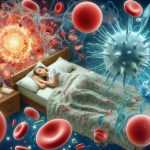HIV is a unique RNA virus that targets the body’s immune system, compromising our body’s ability to fight off everyday infections. While HIV is no longer a death sentence and can be managed effectively with treatment, it’s still a complex infection.

Understanding exactly how HIV affects the body has been a fascinating voyage of discovery for scientists and researchers. It’s helped us understand more about the body’s response to the infection and allowed us to improve the lives of those living with HIV. But how exactly does HIV affect the body, and what cells fall victim to the virus?
What Is Hiv?
Human immunodeficiency virus (HIV) is an infection that targets the body’s immune system. HIV compromises our body’s ability to fight off everyday diseases and infections, making sufferers more susceptible to developing serious complications.
HIV is a spectrum of conditions caused by the virus. HIV increases the risk of developing opportunistic infections, most of which are rare in people with healthy immune functions.
HIV is spread primarily via unprotected vaginal and anal sex, contaminated needle use, pregnancy, breastfeeding, and delivery. Although HIV is spread through contaminated bodily fluids, saliva and tears do not spread the virus, and oral sex carries minimal risk of transmission.
Hiv: Symptoms And Infection Stages
When someone becomes infected with HIV, several things start to happen to the body. HIV has three stages: acute HIV, chronic HIV, and AIDS.
Once you become infected with HIV, the infection takes hold immediately. However, symptoms may take days or weeks to appear.
However, symptoms can be so mild that you might not even realize they’re characteristic of HIV. Symptoms in the initial stages of HIV infection are mostly flu-like and can include:
- Headache
- Rash
- Fatigue
- Muscle pain
- Fever
- Swollen Lymph Nodes
Flu-like symptoms start to present as multiple copies of the HIV infection are created and spread throughout the body. This acute stage of infection is also when people with HIV are most likely to spread the infection to others. The acute stage can last anywhere between several weeks and months.
In the asymptomatic or latent stage of HIV, you may not have any symptoms. This is because the virus isn’t multiplying as quickly in your body.
Without treatment, you’ll still have a detectable viral load that can be spread easily to others. The chronic stage of HIV may also last for several years before eventually turning into AIDS.
Several factors can affect the progression of the disease, including what age symptoms start, if the sufferer can achieve viral suppression through antiretroviral medications, your health condition before you start treatment, genetic history, and general lifestyle.
What Cells Does Hiv Attack?
When HIV takes hold, it takes a specific immune system cell in the body called the CD4 cell. The CD4 cells, also called the helper cells or t cells, are white blood cells responsible for maintaining regular immune function.
CD4 cells are called helper cells because while they don’t neutralize infections in the body, they trigger the body’s responses to fight the infections. When CD4 cells are compromised, the body loses its ability to fight infection. This could make viruses as minor as the common cold dangerous for people with HIV.
HIV doesn’t just attack CD4 cells: it also uses these cells to create more of the HIV virus. HIV starts destroying CD4 cells by using its own replication capabilities to create numerous copies of the HIV virus – this will eventually cause the body’s CD4 cells to break down and eventually burst.
Essentially, HIV binds itself to the CD4 molecule. It sits on the surface of helper cells or T-cells and replicates within them. The genetic code of the virus then becomes part of the CD4 cells.
When the body faces infection and multiplies the CD4 count to fight it, it ends up creating more HIV, which further reduces the count of CD4 cells in the body.
A CD4 cell count is used to determine the health of HIV sufferers. Once the HIV virus has destroyed a certain number of CD4 cells and the count drops below 200, a person will be classed as progressing to AIDS.
In a healthy immune system, the normal CD4 count can range anywhere between 500 to 1600 cells per cubic millimeter of blood. The AIDS diagnosis is given when the CD4 count falls below 200 cells per cubic millimeter of blood.
Other cells in the body may also be targets for HIV, including macrophages, monocytes, B cells, and more. However, T Cells are the primary HIV target and act as the host for the virus to replicate.
Cell Hijacking: The Science Behind Hiv
In a healthy T Cell, the nucleus will communicate with the rest of the cell and transform DNA into RNA. When DNA is converted into RNA, it’s sent out into the body to be the messenger between the nucleus and the cell.
However, HIV is considered a retrovirus because it can transform RNA into DNA, essentially reversing the natural processes that occur in our cells.
Once the transformation happens, the newly viral DNA will head straight to the nucleus of the T cell and bind itself to the cell’s DNA, essentially hijacking the cell.
If the t cell is activated, this is where HIV will start to replicate and produce more HIV in the body rather than performing normal functions of the t cell.
The Bottom Line
HIV has a high mutation rate and evolves rapidly. Unfortunately, the rapid evolution of HIV in the body has made it hard for scientists to develop an effective vaccine against the virus. The complexity of the virus may also reduce the efficacy of some drugs.
While there’s no cure for HIV, treatments do exist to manage the disease and improve the quality of life of people living with HIV. With the right support and treatment, most people living with HIV can continue to lead healthy and fulfilling lives.
- Understanding Male Reproductive Health: A Complete Guide - February 2, 2025
- Simple Healthy Skin Habits for Radiant Skin - December 6, 2024
- Unlocking the Connection Between Nutrition and Mental Health - December 3, 2024








